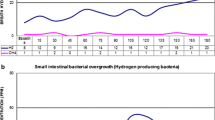Abstract
PURPOSE: Bacterial overgrowth sometimes complicates the clinical course of Crohn's disease and may lead to inappropriate treatment. To clarify the effect of antibiotic therapy, we monitored the hydrogen concentration in expiratory breath after fasting. METHODS: We evaluated 18 patients (15 males; median age, 32.7; range, 22.3–60 years) for postoperative bacterial overgrowth symptoms and for intestinal dilation by plain abdominal x-ray. Five patients had ileitis and 13 patients had ileocolitis. Various intestinal resections were performed in all, and strictureplasties were done at the same time in 13 patients. The median postoperative period was 10.2 (range, 1.2–102) months. Nine patients, who had symptoms such as bloating, nausea, vomiting, or pain, were classified as the symptomatic group, whereas nine other patients, who had no symptoms, were classified as the symptom-free group. Sixteen patients who had undergone intestinal resections for noninflammatory bowel disease served as the control group. After overnight fasting, hydrogen concentration in end-expiratory breath was measured with gas chromatography. At the same time clinical examinations of white blood cell count, hemoglobin, total protein, serum albumin, iron, sialic acid, and C-reactive protein in the peripheral blood were performed. To assess the effect of antibacterial treatment, changes in symptoms were assessed in eight patients who received antibacterial treatment. Hydrogen concentration was measured repeatedly before and after treatment in six patients. RESULTS: The symptomatic group had an expiratory hydrogen concentration level significantly higher (median, 40; range, 20–139 ppm) than the control group (median, 3; range, 1–6 ppm) and the symptom-free group (median, 4; range, 1–10 ppm). After the antibiotic treatment the symptoms were improved in all of the patients, and the hydrogen concentration level was significantly reduced (median, 4.5; range, 2–13 ppm). CONCLUSIONS: Antibacterial treatment was useful in the postoperative patients whose assessments were complicated by bacterial overgrowth. Using a hydrogen breath test, bacterial overgrowth was effectively monitored and managed, effecting a change in clinical symptoms.
Similar content being viewed by others
References
Beeken WL, Kanich RE. Microbial flora of the upper small bowel in Crohn's disease. Gastroenterology 1973;65:390–7.
Rutgeerts P, Ghoos Y, Vantrappen G, Eyssen H. Ileal dysfunction and bacterial overgrowth in patients with Crohn's disease. Eur J Clin Invest 1981;11:199–206.
Corazza GR, Strocchi A, Gasbarrini G. Fasting breath hydrogen in celiac disease. Gastroenterology 1987;93:53–8.
Perman JA, Modler S, Barr RG, Rosenthal P. Fasting breath hydrogen concentration: normal values and clinical application. Gastroenterology 1984;87:1358–63.
Hoverstad T, Bjorneklett A, Fausa O, Midtvedt T. Short-chain fatty acids in the small-bowel bacterial overgrowth syndrome. Scand J Gastroenterol 1985;20:492–99.
Sadlack B, Merz H, Schorle H, Schimpi A, Feller AC, Horak I. Ulcerative colitis-like disease in mice with a disruptive interleukin-2 gene. Cell 1993;75:253–61.
Kuhn R, Lohler J, Rennick D, Rajewsky K, Mullere W. IL-10 deficient mice develop chronic enterocolitis. Cell 1993;75:263–74.
Strocchi A, Corazza G, Ellis CJ, Gasbarrini G, Levitt MD. Detection of malabsorption of low doses of carbohydrate: Accuracy of various breath H2 criteria. Gastroenterology 1993;105:1404–10.
Metz G, Gassull MA, Drasar BS, Jenkins DJ, Blendis LM. Breath-hydrogen test for small intestinal bacterial colonization. Lancet 1976;1:668–9.
Corazza GR, Strocchi A, Gasbarrini G. Fasting breath hydrogen in celiac disease. Gastroenterology 1987;93:53–8.
Salen G, Goldstein F, Wirts CW. Malabsorption in intestinal scleroderma. Relation to bacterial flora and treatment with antibiotics. Ann Intern Med 1966;64:834–41.
Welkos SL, Toskes PP, Baer H, Smith GW. Importance of anaerobic bacteria in the cobalamin malabsorption of the experimental rat blind loop syndrome. Gastroenterology 1981;80:313–20.
Vantrappen G, Janssens J, Hellemans J, Ghoos Y. The interdigestive motor complex of normal subjects and patients with bacterial overgrowth of the small intestine. J Clin Invest 1977;59:1158–66.
Justus PG, Fernandez A, Martin JL, King CE, Toskes PP. Altered myoelectric activity in the experimental blind loop syndrome. J Clin Invest 1983;72:1064–71.
Verne GN, Eaker EY, Hardy E, Sninsky CA. Effect of octreotide and erythromycin on idiopathic and scleroderma-associated intestinal pseudoobstruction. Dig Dis Sci 1995;40:1892–901.
Author information
Authors and Affiliations
Additional information
Read at the meeting of The Surgical Society of Alimentary Tract, Washington, D.C., May 11 to 14, 1997.
About this article
Cite this article
Funayama, Y., Sasaki, I., Naito, H. et al. Monitoring and antibacterial treatment for postoperative bacterial overgrowth in Crohn's disease. Dis Colon Rectum 42, 1072–1077 (1999). https://doi.org/10.1007/BF02236706
Issue Date:
DOI: https://doi.org/10.1007/BF02236706




